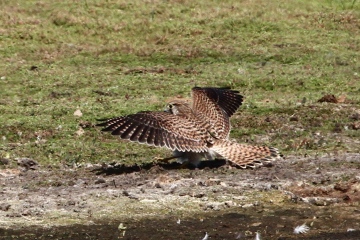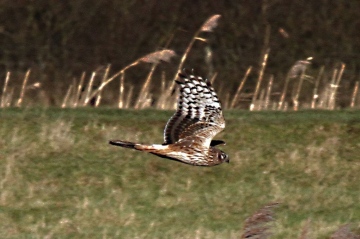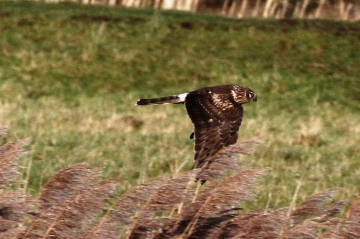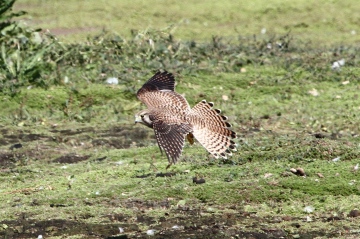Unfortunately “shot†is an all too appropriate word when applied to Hen Harriers as they are illegally persecuted on their moorland breeding grounds, particularly in northern England and Scotland. Indeed, the RSPB estimate that there is sufficient habitat for around 300 pairs in England, yet last summer only two pairs attempted to nest and both of them failed. The trouble is they feed on small mammals and birds, including grouse chicks, and grouse shooting is worth a lot of money, an estimated £240,000,000 to the Scottish economy alone. If there are huge numbers of fluffy little chicks scurrying about in the heather it would be a dumb bird of prey that did not make the most of this largesse; thus there is a conflict of interest between conservationists and estate managers but nothing can excuse the visceral hatred of “hookbills†and other predators displayed by some in the shooting lobby. When the latter talk of the need to ‘control’ predators, including birds of prey, conservationists can justly point to the Hen Harrier as a case where ‘control’ has become more like extermination. Victorian habits die hard among some in the shooting fraternity!
Although such conflicts are normally associated with shooting interests they can be an issue in conservation as well, especially at a local level. There have been instances of serious predation of Sandwich Tern chicks by Grey Herons on Anglesey and in Norfolk and of Little Tern colonies being all but wiped out by Kestrels elsewhere in East Anglia. When you are trying to conserve birds that are facing a number of other threats to their existence such as habitat fragmentation, increased disturbance, and the loss of their principal food supply including – in the case of many seabirds – sandeels (perhaps due to the effects of global warming) heavy predation at a local level can tip the balance.
A bird of prey that is currently doing well in Essex is the Buzzard. When I was a boy the idea that Buzzards would one day be a common sight soaring above the woodlands around Ingatestone was beyond my wildest imaginings. Devon was the nearest place you could hope to see them – a rare holiday treat. Yet last year at least five pairs bred in the parish and surrounding area and their beautiful mewing calls were a frequent accompaniment on my walks. They have spread eastwards thanks to a reduction in persecution, at least in southern England, and are now a common sight throughout the county. Now, inevitably, there are calls from some in the shooting lobby that they need to be ‘controlled’. One gamekeeper, interviewed on the BBC’s ‘Country File’ programme, claimed that Buzzards were killing a thousand Pheasant pullets on his shoot each autumn. I think that he was coming it a bit. Ten Buzzards (a ridiculously high concentration in one area except when on migration) would each need to eat a pheasant a day for over three months in order to achieve this level of mortality while three Buzzards (a more realistic figure) would take the best part of a year. And that’s if they ate nothing else. There must be some very fat Buzzards on his estate! Our local gamekeeper did have some trouble with recently fledged young Buzzards trying to make their way in the world, which saw his pheasant pens as a tempting target, but he largely got round the problem by festooning the pens with tinfoil, CDs, tin cans, and other oddments that banged and clattered and flashed silvery in the breeze. Finding alternative, non-lethal, methods to deal with these conflicts (such as supplementary feeding with domestic white rats and poultry chicks in the case of Hen Harriers) is what conservationists and some members of the shooting lobby are attempting to promote but there are some deeply entrenched views out there and they face an uphill task.
Many recently fledged young raptors struggle to survive during their first few months of independence – hence the attraction of pheasant pullets – and many die of starvation during this period. The young Kestrel pictured here (also photographed by John at Blue House) found a novel solution.
 He discovered that the New Zealand Pygmy Weed which infests the main wader breeding area on the farm was, despite its bad reputation, rich in earthworms and other invertebrates and for two months after fledging it feasted on these (supplementing them with craneflies in September) while at the same time honing his hovering and pouncing skills. He seemed to spot the worms from up to thirty feet away, perhaps detecting some slight movement as they moved beneath the weed. Having secured the worm he would hold it in one foot and draw the body through his beak, expelling all the earth and other gunge inside his unfortunate victim before swallowing the nutritious bit that remained!
He discovered that the New Zealand Pygmy Weed which infests the main wader breeding area on the farm was, despite its bad reputation, rich in earthworms and other invertebrates and for two months after fledging it feasted on these (supplementing them with craneflies in September) while at the same time honing his hovering and pouncing skills. He seemed to spot the worms from up to thirty feet away, perhaps detecting some slight movement as they moved beneath the weed. Having secured the worm he would hold it in one foot and draw the body through his beak, expelling all the earth and other gunge inside his unfortunate victim before swallowing the nutritious bit that remained!





















